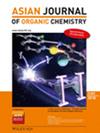Photocatalytic Csp2−H Amination of Hydrazones with N‐aminopyridinium Salts
IF 2.8
4区 化学
Q1 CHEMISTRY, ORGANIC
引用次数: 0
Abstract
The current approach describes Csp2−H amination of aldehyde‐derived hydrazones via nitrogen centred radical generation from N‐aminopyridinium salts under photocatalytic conditions. The scope of reaction is wide in terms of both the substrates and most of the products were isolated in good yields furnishing Z‐isomer exclusively. Further, aminated hydrazones were hydrolyzed to give amides resulting into indirect Csp2−H amination of aldehydes.
n -氨基吡啶盐光催化Csp2−H胺化腙
目前的方法描述了在光催化条件下,通过氮中心自由基从n -氨基吡啶盐生成醛衍生腙的Csp2−H胺化。反应范围广,底物广,大部分产物产率高,只含z型异构体。进一步,胺化腙被水解得到酰胺,导致醛的间接Csp2−H胺化。
本文章由计算机程序翻译,如有差异,请以英文原文为准。
求助全文
约1分钟内获得全文
求助全文
来源期刊

Asian Journal of Organic Chemistry
CHEMISTRY, ORGANIC-
CiteScore
4.70
自引率
3.70%
发文量
372
期刊介绍:
Organic chemistry is the fundamental science that stands at the heart of chemistry, biology, and materials science. Research in these areas is vigorous and truly international, with three major regions making almost equal contributions: America, Europe and Asia. Asia now has its own top international organic chemistry journal—the Asian Journal of Organic Chemistry (AsianJOC)
The AsianJOC is designed to be a top-ranked international research journal and publishes primary research as well as critical secondary information from authors across the world. The journal covers organic chemistry in its entirety. Authors and readers come from academia, the chemical industry, and government laboratories.
 求助内容:
求助内容: 应助结果提醒方式:
应助结果提醒方式:


